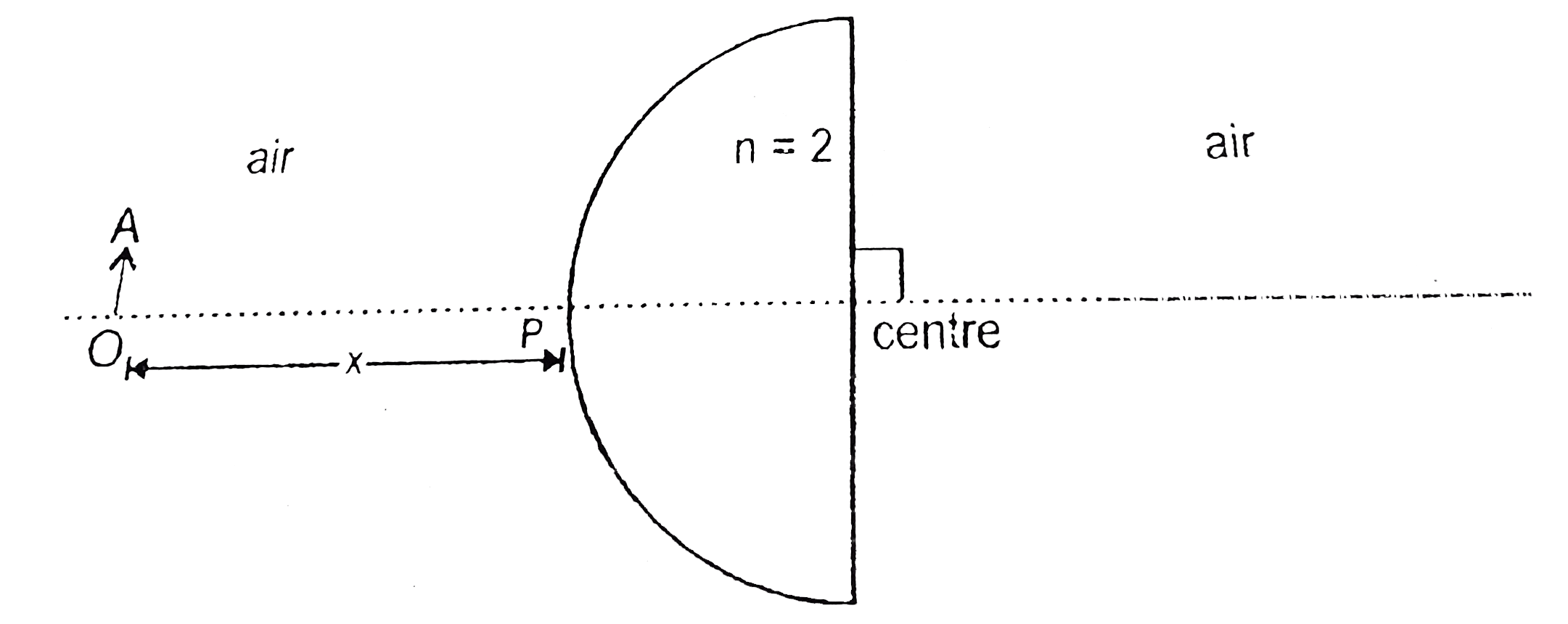
Consider a transparent homogenous hemisphere of refractive index n=2 in front of which a small object is placed in air as shown in figure.
if value of x=3R then the final image of the small object OA will be real & inverted.
If value of x=2R then the final image of the small object OA will be inverted and magnified.
consider a ray starting from O which strikes the spherical surface at grazing incidence (i≅90∘) taking x=R the angle (from normal) at which the ray will emerge from the plane surface is 30∘
consider a ray starting from O which strikes the spherical surface at grazing incidence (i≅90∘). Takin x=R the angle (from normal) at which the ray will emerge from the plane surface is 90∘.
The correct Answer is:A, D
For first surface
2V−1−3R=2−1R⇒2V=1R−13R
2V=23R⇒V=3R
for second surface u=2R
1V=22R⇒V=R Real & inverted.
(B) for first surface
2V−1−2R=2−1R⇒2V=1R−12R
⇒V=4R⇒m1=−1
for second surface u=3R
1V=23R⇒V=3R2 real & inverted and same size.

Similar Questions
Consider a transparent hemispher (n=2) in front of which a small object is placed in air (n=1) as shown in figure.

Q. For which value of x, of the following , will the final image of the object O be virtual?
View SolutionConsider a transparent hemispher (n=2) in front of which a small object is placed in air (n=1) as shown in figure.

Q. What is the nature of final image of the object when x=2R?
View SolutionConsider a transparent hemispher (n=2) in front of which a small object is placed in air (n=1) as shown in figure.

Q. Consider a ray starting from O which strikes the spherical surface at grazing incident (i=90∘). Takin x=R, what will be the angle (from normal) at which the ray may emerge from the plane surface.
View SolutionA person is looking at the flat surface of a transparent hemisphere of refractive index μ=√2 . Half of the flat surface is coloured black and half of curved surface is coloured in six equally spaced strips as shown in Figure. Then

View SolutionIn front of an earthed conductor a point charge +q is placed a shown in figure

View SolutionA parallel beam of light is incident normally on the flat surface of a hemisphere of radius 6cm and refractive index 1.5, placed in air as shown in figure (i). Assume paraxial ray approxiamtion.
 .
.
View SolutionThe diagram shows a spherical surface which separates two media of refractive index, μ1andμ2. Respectively. Now, a point object is placed on the principal axis as shown in the figure. Then

View SolutionA parallel narrow beam of light is incident on the surface of a transparent hemisphere of radius R and refractive index μ=1.5 as shown. The position of the image formed by refraction at the image formed by refraction at the spherical surface only as

View SolutionA small angled prism of apex angle A=4∘ and refractive index μ=1.5 is placed in front of a vertical plane mirror as shown in figure. If the mirror is rotated through an angle θ, then the light ray becomes horizontal either after the mirror or after second time passing from the prism in opposite direction. The value θ is

View SolutionA prism having an apex angle of 4∘ and refractive index of 1.50 is located in front of a vertical plane mirror as shown in the figure. A horizontal ray of light is incident on the prism. The total angle through which the ray is deviated is:

View Solution